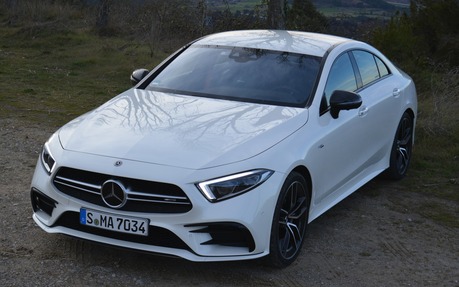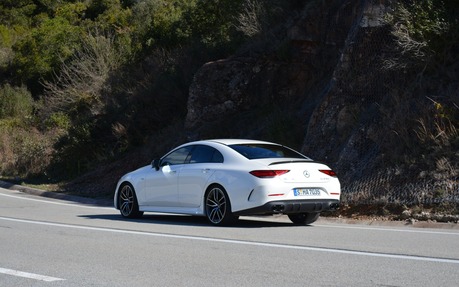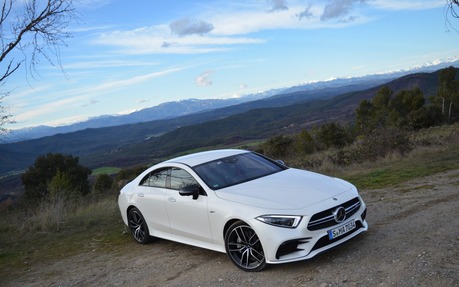2019 Mercedes-Benz CLS: Returning to its Roots
BARCELONA, Spain – They say that imitation is the sincerest form of flattery. It wasn’t long after the Vision CLS concept broke cover some 15 years ago that another carmaker introduced its own vision of a four-door luxury coupé.
Although the niche segment now features a little more than a handful of options, none have been as successful as the CLS. While the first generation W219 broke all moulds, the second-generation W218 car did not. Although sales continued to be strong, much of the magic and intrigue surrounding the original was lost.
- Also: 2019 Mercedes-Benz CLS: the Original Four-door Luxury Coupé
- Also: 2019 Mercedes-Benz CLS: The Inline-6 is Back
For its third round, Mercedes has reinfused mystique into the CLS, making the new C257 car almost as shockingly attractive as the first. The group from Stuttgart did not solely concentrate on the outer shell. Much like the first of its name, the latest car is loaded with new technologies and a brand-new powertrain, all the while taking the best from Mercedes’ design and engineering.

Rolling sculpture
I just recently read a line pertaining to sculptors. Some of the more modest ones say that the final sculpture is already made underneath the raw material. They are simply the ones who chisel off the unwanted pieces.
Gorden Wagener, Chief Design Officer at Daimler AG, described the 2019 CLS as a reinvented original CLS. As he spoke the words, I imagined him chiselling away at the W218, taking away hard edges, exaggerated character lines and creating the car’s new sleek and sensual body. In fact, there are no hard edges on the C257 as a whole. Only the predator face, or shark nose, could be considered sharp.
The CLS is once more strikingly beautiful and modern. The car sits on its 19-inch wheels with a distinctive stance and while the CLS 450 projects power and speed, the Mercedes-AMG CLS 53 and its 20-inch wheels and various aero bits wins the “if I had to pick” category.
The cabin too is exemplary. No one else does a dashboard like Mercedes. For some, the dual 12.3-inch screens fitted beneath a continuous glass cover, light-up vents and cascading dashboard can be too much. I may have thought like this at first, but I quickly found myself happily immersed in the Mercedes experience. However, there is a stark contrast between the CLS’ interior environment and outer shell.
As part of the available kit, the Drive-Dynamic Multicontour front seats with Energizing (massaging, heated, ventilated) function in the CLS 450 are amazing. The CLS 53 gets heavily bolstered units while the Drive-Dynamic seats are optional too. The 2019 edition of the CLS is the first to be rated a five-seater. Width-wise, it works, but headroom remains very tight.
The new three-spoke steering wheel now features integrated cruise control buttons (was on a stalk since forever) and a number of buttons to configure the fully digital cockpit. Cabin technology levels are on the rise. The Smartphone Integration package includes Apple CarPlay and Google Android Auto while LINGUATRONIC voice control now includes a number of vehicle functions such as A/C, seat heating/ventilation, interior lighting and more. The CLS can be as heavily optioned out as an S-Class, if so desired.
Inline power
This is not meant to mean that the CLS cannot handle corners. In fact, the tested car both featured adaptive dampers, some of the best I’ve ever experienced.
The new 2019 Mercedes-Benz CLS will usher in a new family of gasoline engines for the car in Canada. The basics are identical for both versions. It starts with a turbocharged 3.0-litre inline six-cylinder engine, mated in all cases to a nine-speed 9G automatic transmission and a latest version of Mercedes’ 4MATIC AWD (45/55 front/rear split in the CLS 450, continuously variable in the CLS 53) system. They both have EQ Boost technology grafted to the lumps.
The base CLS 450’s twin-scroll turbo mill produces 362 horsepower and 369 lb.-ft. of torque. Although these numbers are commendable, the CLS 53’s twin-turbocharged mill, with 429 horsepower and 384 lb.-ft. of torque, is that much more enticing, and vocal. So, what is EQ Boost? In a nutshell, it’s a 48-volt integrated starter/generator mild-hybrid system that allows “sailing” or coasting without the engine running. It also handles engine start/stop and captures kinetic energy with a regeneration function. Hands down, the best part is that it creates an initial acceleration boost. It uses its integrated electric auxiliary compressor, which revs to 70,000 rpm in 0.3 second, to prime the turbocharger.
The way EQ Boost works is mostly noticeable in stop-and-go traffic. The start/stop loop is imperceptible, as is the preliminary kick. On paper, output is bumped by a further 21 horsepower and 184 lb.-ft. of torque, but overall, power delivery is immensely linear. The CLS 53’s extra state of tune, both in sound and yield, seems to benefit more readily from EQ Boost. The CLS 53 felt much faster, and more responsive.

On the road, the new CLS is far from lively, but it handles multiple switchbacks and tremendous weight transfers as though they were nothing. Through Dynamic Select, the various drive modes have a direct impact on throttle, steering and chassis and when set to Sport or Sport+, the car sits flat no matter what. In Comfort mode, the dampers provide generous travel and a plush ride. Few cars have such a widely varying suspension tuning.
The downsides to the car’s on-road behaviour are limited to brakes and steering. I know this sounds like horrible problems but, well, they’re not. Steering has an annoying tendency to want to aggressively return on-centre—I felt as though I was wrestling with the wheel to hold my line through a corner. Brake pedal response was wooden and once the binders began their works, little feedback was returned. I suspect this is a brake-by-wire tuning issue that can probably be easily resolved.
The new face of Mercedes
The 2019 Mercedes-Benz CLS marshals not only new technologies for the storied luxury brand, but introduces us to a new design language. Mr. Wagener mentioned it in his brief walk-around of the car that much like the W219 CLS, the new car has become the brand’s halo car.
As the core business evolves, so do criteria that determine what a halo car is. The 2019 Mercedes CLS is a gorgeous piece of work and is lovely to drive. In 2018, this is not enough for such a prestigious title. Its new EQ Boost mild hybrid setup, that improves performance and fuel economy (ratings not yet available), and acres of technology, connectivity and creature comforts are what seal the deal.
What an impressive automobile. It arrives at dealerships in this fall.
| Test drive report | |
| Test model | 2019 Mercedes-Benz CLS |
|---|---|
| Trim level | AMG 53 4Matic |
| Price range | $95,000 – $135,000 |
| Price as tested | CA$135,000 |
| Warranty (basic) | 4 years/80,000 km |
| Warranty (powertrain) | 4 years/80,000 km |
| Fuel economy (city/highway/observed) | 13.3 / 8.5 / N/A L/100km |
| Options | N/A |
| Competitive models | Aston Martin Rapide, Audi A8, BMW 7 Series, Jaguar XJ, Tesla Model S |
| Strong points |
|
| Weak points |
|
| Editor's rating | |
| Fuel economy | EQ Boost will help with city driving. This is still a large four-door car. |
| Comfort | Great seats, spacious 520-litre trunk. |
| Performance | The CLS 450 will be enough for most, but the AMG CLS 53’s extra oomph is addictive. |
| Infotainment | Huge screens, numerous and intuitive menus, plus Burmester audio! |
| Driving | Adaptive dampers are a must—they transform the car from big saloon to sporty sedan. |
| Overall | Gorgeous symbol of opulence and good taste. Wonderful car. |
